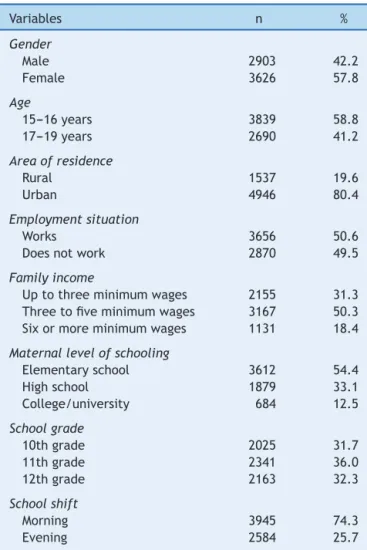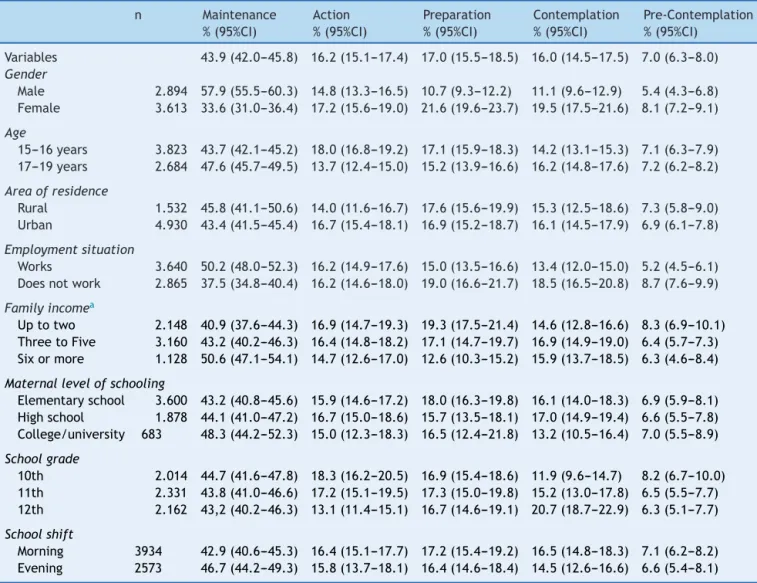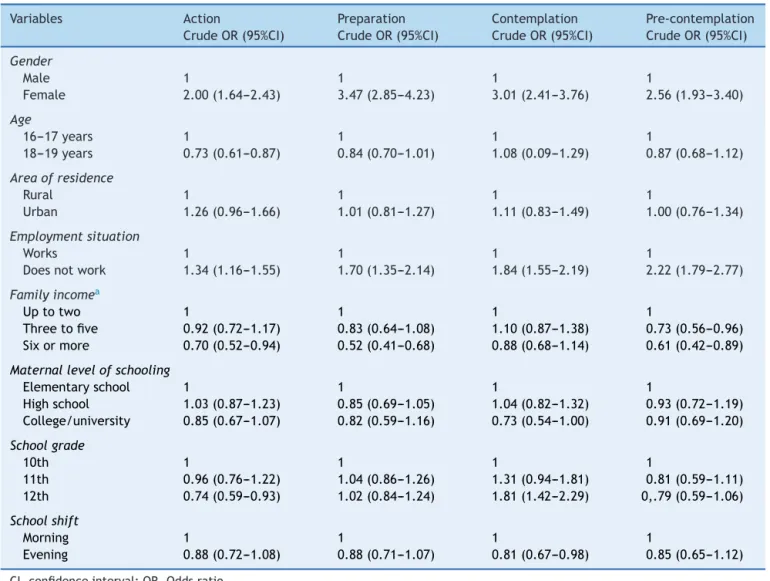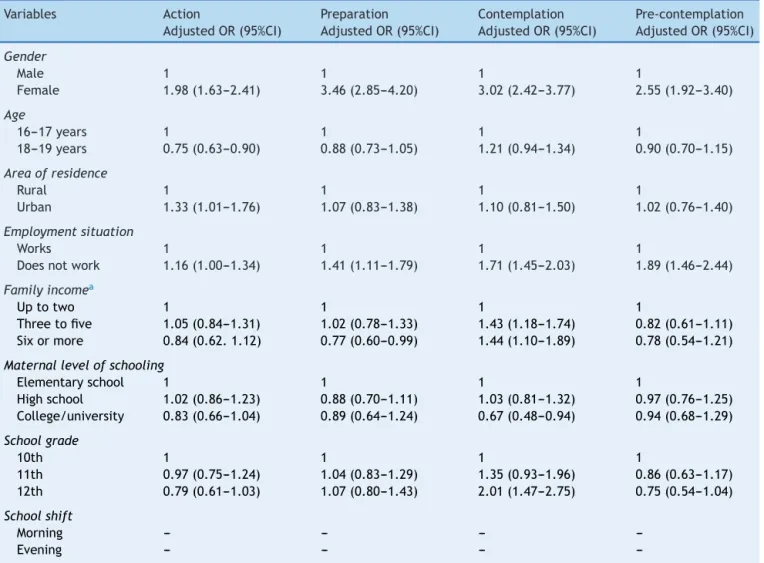REVISTA
PAULISTA
DE
PEDIATRIA
www.rpped.com.br
ORIGINAL
ARTICLE
Behavior
change
stages
related
to
physical
activity
in
adolescents
from
Santa
Catarina:
prevalence
and
associated
factors
Jaqueline
Aragoni
da
Silva
∗,
Kelly
Samara
da
Silva,
Adair
da
Silva
Lopes,
Markus
Vinícius
Nahas
UniversidadeFederaldeSantaCatarina(UFSC),Florianópolis,SC,Brazil
Received23November2015;accepted8March2016 Availableonline11August2016
KEYWORDS
Physicalactivity; Exercise; Adolescent; Behavior;
Theoreticalmodels; Epidemiology
Abstract
Objective: Verifytheprevalenceandsociodemographicandeconomicfactorsassociatedwith behaviorchangestagesforhabitualphysicalactivitypracticeinadolescentsfromSanta Cata-rina.
Methods: Secondaryanalysisofastudy ontheBehaviorofAdolescentsfromSanta Catarina (CompAC2).Cross-sectionalschool-basedstudyof6,529high-schoolstudents(males,n=2,903) fromthestateofSantaCatarinapubliceducationsystemin2011,aged15to19years. Multi-nomiallogisticregression(crudeandadjusted)wasusedtomeasuretheassociation.
Results: Thehighestandlowestprevalencerateswerefoundinthemaintenance(43.9%)and precontemplationstages(7.0%),respectively.Thestagesofaction,preparationand contempla-tionshowedsimilarresults:16.2%;17.0%and15.6%;respectively.Maleadolescentsshowhigher prevalenceinthemaintenancestageinrelationtofemalesandtheseshowahigherprevalence inpreparation,contemplationandprecontemplation.Alltheassessedvariables(gender,age, areaofresidence,employmentstatus,familyincome,maternaleducationandschoolgrade), withtheexceptionofschoolshift,wereassociatedwithatleastoneofthestages.
Conclusions: A large proportion ofadolescents areinthe pre-adoptionstages andmostof thesehavetheintentiontostartregularphysicalactivity.Withtheexceptionofschoolshift, theassessedvariableswereassociatedwithstagesindifferentways,showingdifferentprofiles inrelationtosociodemographicandeconomiccharacteristicsineachsubgroup.
©2016SociedadedePediatriadeS˜aoPaulo.PublishedbyElsevierEditoraLtda.Thisisanopen accessarticleundertheCCBYlicense(http://creativecommons.org/licenses/by/4.0/).
∗Correspondingauthor.
E-mail:jaquiaragoni@hotmail.com(J.A.Silva).
http://dx.doi.org/10.1016/j.rppede.2016.03.017
PALAVRAS-CHAVE
Atividadefísica; Exercício; Adolescente; Comportamento; Modelosteóricos; Epidemiologia
Estágiosdemudanc¸adecomportamentoparaatividadefísicaemadolescentes catarinenses:prevalênciaefatoresassociados
Resumo
Objetivo: Verificarasprevalênciaseosfatoressociodemográficoseeconômicosassociadosaos estágiosdemudanc¸adecomportamentoparapráticahabitualdeatividadefísicaem adoles-centescatarinenses.
Métodos: Análisesecundária deestudosobreoComportamentodoAdolescenteCatarinense (CompAC2).Estudotransversaldebaseescolarcompostopor6.529escolares(sexomasculino, n=2.903)do ensinomédio daredepública estadual deSanta Catarinaem 2011, entre15 a 19anos.Paramedidadeassociac¸ão,usou-seregressãologísticamultinomial(brutaeajustada).
Resultados: As prevalências mais elevadas e mais baixas foram verificadas nos estágios de manutenc¸ão (43,9%) e pré-contemplac¸ão (7%), respectivamente. Os estágios de ac¸ão, preparac¸ãoecontemplac¸ãoapresentaramresultadossemelhantesentresi:16,2%,17%e15,6%, respectivamente. Adolescentes do sexo masculino estão em maior prevalência no estágio de manutenc¸ão emrelac¸ão aosdo sexofemininoeessas apresentammaiorprevalênciaem preparac¸ão,contemplac¸ãoepré-contemplac¸ão.Todasasvariáveisinvestigadas(sexo,idade, áreademoradia,situac¸ãoocupacional,rendafamiliar,escolaridadematernaesérieescolar), comexcec¸ãodoturnodeestudo,apresentaramassociac¸ãocompelomenosumdosestágios.
Conclusões: Grandeparceladosadolescentesencontra-senosestágiosdepré-adoc¸ãoea maio-riadessestemaintenc¸ãodeiniciarapráticaregulardeatividadefísica.Comexcec¸ãodoturno deestudo,asvariáveisinvestigadasestiveramassociadasaosestágiosdediferentesformas, apresentaram perfis distintos em relac¸ãoàscaracterísticas sociodemográficaseeconômicas emcadasubgrupo.
©2016SociedadedePediatriadeS˜aoPaulo. PublicadoporElsevier EditoraLtda.Este ´eum artigoOpenAccesssobumalicenc¸aCCBY(http://creativecommons.org/licenses/by/4.0/).
Introduction
Thereisagrowinginterestintheunderstandingof behav-iorrelatedtophysicalactivity(PA),1duetotherecognition
of its importancein health maintenance.2 Given the fact
thatpatternsofPApracticeinadolescencetendtocontinue
into adulthood,3 studies that investigate the behavior of
youngindividualsisofgreatimportance.Additionally,
sev-eraltheorieshavecontributedtoimprovetheunderstanding
ofPA-relatedbehavior,givenitscomplexity.4The
transthe-oreticalmodelisoneofthem,consistingoffourconstructs
ofwhichStagesofBehaviorChange(SBC)arethemostoften
researched.5
The SBCrecommends thattheindividualfollowstages,
moving forward and/or backward within them toachieve
a certain desired behavior, such as, for instance, regular
PA practice.6 The model aims to elucidate motivational,
behavioralandtemporalaspectsoftheindividualtochange
behavior.7 This model hasadvantages, such asthe
identi-ficationofboth theindividual’swillingness,aswellasthe
transitiontoPApractice.8Theeffectivenessofinterventions
onPAbasedonthismodelhasbeendemonstrated,9asitis
possibletoclassifyinmoredetailstheindividual’sintentand
differentiatethosewhoarewillingtochange their
behav-ior fromthosewhoarenot.6 As for thestage,individuals
inprecontemplation donotplantochangetheirbehavior,
i.e.,there isno intentiontostart PA practice.As for the
contemplation stage, individuals think about the
possibil-ityofchange,withinaperiodofapproximatelysixmonths.
Thosein thepreparationstagehave certaingoalstostart
PApracticeinthe nearfuture, set at 30days.Individuals
whoareintheactionstagehaverecentlystartedthe
reg-ularpracticeofPA.Wheninmaintenance,individualshave
practicedPAfor morethan sixmonths,thatis, theyhave
achievedtheirbehaviorchange.7
Studies show that each stage has its particular
characteristics.8 Thus, in addition toknowing the SBC in
whichtheadolescentis,wemustalsoknowwhatis
associ-atedwitheachstage,clarifyexternalaspects(environment
wherethesubjectis)andwhatfactorsarecharacteristicat
eachlevelofPA-relatedbehavior.10Evidencesuggeststhat
sociodemographicindicatorscanplay animportantrolein
relationtoSBC.11 Inrelationtogenderandage,studies12,13
indicatethatgirlsandoldermaleadolescentsareclassified
in the pre-contemplation, contemplation and preparation
stages, whereas boys and younger adolescentsare in the
stagesofactionandmaintenance.
Itisnoteworthythat,duetothesizeandcultural
diver-sity of Brazil, different levels of PA-related behavior can
beverifiedaccordingtotheindividual’splaceofresidence
(region,state).Thus, studies withrepresentativesamples
of adolescents allow us to extrapolate the results and
help to define the profile of this population in different
locations.
Therefore,thepresent studyaimed toestimate
preva-lence and assess sociodemographic and economic factors
associatedwithSBCforusualPApracticeinadolescentsfrom
the state of Santa Catarina, Brazil. These questions may
clarifyexistinggaps,assistinfutureinterventionsandallow
Method
Secondary analysis of the CompAC 2 project (Behavior of Adolescents from Santa Catarina), which portrayed the lifestyleandriskbehaviorofyoungindividualsinSanta Cata-rinain2011.Thisisaschool-basedepidemiologicalsurvey consistingofhigh-schoolstudentsaged15---19years, attend-ingpublichighschoolsinthestateofSantaCatarina,Brazil. TheprojectwassubmittedtotheInstitutionalReviewBoard ofUniversidadeFederaldeSantaCatarinaandobtainedits approval(Processn.1029/2010).
Based ontheestimate of theadolescent population in SantaCatarina(205,572)in2010,14thesamplewasstratified
accordingtosix geographicalregions, takinginto account
the distribution of Regional Education Secretariats. Lots
weredrawintwostages(sizeofschoolsandclasses---school
grade and shift). As several research phenomena were
addressed,thefollowingstatisticalparameterswere
consid-ered:unknownprevalence(p=50%);95%confidenceinterval
and sample error of two percentage points. The sample
designeffectwasalsoconsidered(deff=2),aswellasa
per-centageof 25% for possible losses or refusals duringdata
collection.The finalsamplesizeconsistedof 6175
adoles-cents.Thestudyhad6569studentsasparticipants;however,
therewasalossof40questionnaires(incompletedata).Only
thosewhoansweredthequestionsrelatedtoSBC,oratotal
of6507adolescents,werepartofthisstudy.
The applied questionnaire was previously tested.14
Demographic (gender, age, residence area, employment
status,schoolshift, grade)and economic (familyincome,
maternal education) data were assessed. The following
questionwasusedtoassessSBC:‘‘Ayoungindividualis
con-sideredtobephysicallyactivewhenhe/sheaccumulatesat
least60minofmoderatetovigorousPAonfiveormoredays
aweek. RegardingyourPApracticehabits,youwouldsay:
(a)Ihavebeen physicallyactivefor morethansixmonths
(maintenance);(b)Ihavebeenphysicallyactiveforlessthan
sixmonths (action);(c)I amnot, butI intendtobecome
physicallyactivewithinthenext30days(preparation);(d)
Iam not,but I intendtobecome physically activein the
nextsixmonths (contemplation);(e) Iam notanddonot
intendtobecome physicallyactiveinthenextsixmonths
(pre-contemplation)’’.
Descriptive statistics were used (absolute and relative
frequencies) and 95% confidence intervals for the
preva-lenceintheSBC.Multinomiallogisticregression(crudeand
adjusted)wasalsousedtoanalyzetheassociationsbetween
independentvariablesandoutcome.Themaintenancestage
wastreatedasthereferencecategory.Intheadjusted
anal-ysis, a p<0.20 was considered for the permanence of the
variablesinthefinalmodelandthehierarchicalmodelwas
usedonthreelevels(distallevel:genderandage;
intermedi-atelevel:residencearea,employmentstatus,familyincome
andmaternal education;proximal level:schoolgradeand
shift).
Results
Table 1 shows the sociodemographic and economic
char-acteristics of the study sample. Of the 6507 adolescents,
mostwere female (57.8%)aged between15 and 16 years
Table 1 Sociodemographic andeconomic characteristics ofadolescents from publichigh schoolsin Santa Catarina (2011).
Variables n %
Gender
Male 2903 42.2 Female 3626 57.8
Age
15---16years 3839 58.8 17---19years 2690 41.2
Areaofresidence
Rural 1537 19.6 Urban 4946 80.4
Employmentsituation
Works 3656 50.6 Doesnotwork 2870 49.5
Familyincome
Uptothreeminimumwages 2155 31.3 Threetofiveminimumwages 3167 50.3 Sixormoreminimumwages 1131 18.4
Maternallevelofschooling
Elementaryschool 3612 54.4 Highschool 1879 33.1 College/university 684 12.5
Schoolgrade
10thgrade 2025 31.7 11thgrade 2341 36.0 12thgrade 2163 32.3
Schoolshift
Morning 3945 74.3 Evening 2584 25.7
(58.8%) lived in urban areas (80.4%) and were employed (50.6%). There was a higher proportion of students with familyincomeofthreetofiveminimumwages(50.3%)and maternaleducationalleveluptoelementaryschool(54.4%). Regardingtheschoolyear,themajorityoftheadolescents wereon11thgrade(36%),withmostofthestudents attend-ingthedayshift(74.3%).
TheoveralldistributionofadolescentsaccordingtoSCB indicated a higher prevalence in the maintenance stage (43.9%; 95%CI: 42---45.8). The stages of action (16.2%; 95%CI: 15.1---17.4), preparation (17%; 95%CI: 15.5---18.5) and contemplation (16%; 95%CI: 14.5---17.5) showed sim-ilar prevalence, whereas pre-contemplation (7%, 95%CI: 6.5---7.8)hadasignificantlylowerprevalencethantheother stages.Whenanalyzedbygender,therewasahigher preva-lence in the maintenance stage in males compared to females.Intheactionstage,therewerenostatistically sig-nificantdifferences.Ontheotherhand,therewasahigher prevalenceofgirlsinthestagesofpreparationand contem-plationinrelationtoboys.Similarly,therewasalsoahigher prevalenceofgirlsthanboysinthepre-contemplationstage.
Table 2 shows the distribution of adolescents by SBC
accordingtosociodemographicfactors.Inthemaintenance
Table2 Prevalenceofadolescentsatthebehaviorchangestagesaccordingtosociodemographicandeconomicfactors. n Maintenance Action Preparation Contemplation Pre-Contemplation
%(95%CI) %(95%CI) %(95%CI) %(95%CI) %(95%CI) Variables 43.9(42.0---45.8) 16.2(15.1---17.4) 17.0(15.5---18.5) 16.0(14.5---17.5) 7.0(6.3---8.0)
Gender
Male 2.894 57.9(55.5---60.3) 14.8(13.3---16.5) 10.7(9.3---12.2) 11.1(9.6---12.9) 5.4(4.3---6.8) Female 3.613 33.6(31.0---36.4) 17.2(15.6---19.0) 21.6(19.6---23.7) 19.5(17.5---21.6) 8.1(7.2---9.1)
Age
15---16years 3.823 43.7(42.1---45.2) 18.0(16.8---19.2) 17.1(15.9---18.3) 14.2(13.1---15.3) 7.1(6.3---7.9) 17---19years 2.684 47.6(45.7---49.5) 13.7(12.4---15.0) 15.2(13.9---16.6) 16.2(14.8---17.6) 7.2(6.2---8.2)
Areaofresidence
Rural 1.532 45.8(41.1---50.6) 14.0(11.6---16.7) 17.6(15.6---19.9) 15.3(12.5---18.6) 7.3(5.8---9.0) Urban 4.930 43.4(41.5---45.4) 16.7(15.4---18.1) 16.9(15.2---18.7) 16.1(14.5---17.9) 6.9(6.1---7.8)
Employmentsituation
Works 3.640 50.2(48.0---52.3) 16.2(14.9---17.6) 15.0(13.5---16.6) 13.4(12.0---15.0) 5.2(4.5---6.1) Doesnotwork 2.865 37.5(34.8---40.4) 16.2(14.6---18.0) 19.0(16.6---21.7) 18.5(16.5---20.8) 8.7(7.6---9.9)
Familyincomea
Uptotwo 2.148 40.9(37.6---44.3) 16.9(14.7---19.3) 19.3(17.5---21.4) 14.6(12.8---16.6) 8.3(6.9---10.1) ThreetoFive 3.160 43.2(40.2---46.3) 16.4(14.8---18.2) 17.1(14.7---19.7) 16.9(14.9---19.0) 6.4(5.7---7.3) Sixormore 1.128 50.6(47.1---54.1) 14.7(12.6---17.0) 12.6(10.3---15.2) 15.9(13.7---18.5) 6.3(4.6---8.4)
Maternallevelofschooling
Elementaryschool 3.600 43.2(40.8---45.6) 15.9(14.6---17.2) 18.0(16.3---19.8) 16.1(14.0---18.3) 6.9(5.9---8.1) Highschool 1.878 44.1(41.0---47.2) 16.7(15.0---18.6) 15.7(13.5---18.1) 17.0(14.9---19.4) 6.6(5.5---7.8) College/university 683 48.3(44.2---52.3) 15.0(12.3---18.3) 16.5(12.4---21.8) 13.2(10.5---16.4) 7.0(5.5---8.9)
Schoolgrade
10th 2.014 44.7(41.6---47.8) 18.3(16.2---20.5) 16.9(15.4---18.6) 11.9(9.6---14.7) 8.2(6.7---10.0) 11th 2.331 43.8(41.0---46.6) 17.2(15.1---19.5) 17.3(15.0---19.8) 15.2(13.0---17.8) 6.5(5.5---7.7) 12th 2.162 43,2(40.2---46.3) 13.1(11.4---15.1) 16.7(14.6---19.1) 20.7(18.7---22.9) 6.3(5.1---7.7)
Schoolshift
Morning 3934 42.9(40.6---45.3) 16.4(15.1---17.7) 17.2(15.4---19.2) 16.5(14.8---18.3) 7.1(6.2---8.2) Evening 2573 46.7(44.2---49.3) 15.8(13.7---18.1) 16.4(14.6---18.4) 14.5(12.6---16.6) 6.6(5.4---8.1)
CI,confidenceinterval.
a Minimumwages.
thosewhoworkedcomparedtothosewhodidnotwork,as wellasamongadolescentswhosefamilyearnedmorethan sixminimumwagesinrelationtootherincomecategories. Asfortheactionstage,wefoundahigherprevalenceamong 10thgradestudentsin relationtothe12thgradeones. In the preparation stage, there was a higher proportion of thosewithfamilyincomeuptothreeminimumwageswhen comparedtoadolescentswhosefamiliesearnedmorethan sixwages.Inthecontemplationstage,therewasahigher prevalenceof adolescentswhodidnotworkin relationto theirpeers.Moreover,12thgradestudentsshowedahigher prevalencewhencomparedtotheothergrades.Finally,in thepre-contemplationstage,adolescentswhodidnotwork showedahigherprevalencethanthosewhodid.
Theresultsforthecrudeandadjustedmultipleanalysis (referencecategory:Maintenance)showedsimilaritiesand canbeseeninTables3and4.Afteradjustingthedata,itwas
foundthattherewasagreaterchanceforadolescentgirls,
youngerindividualsandthoseresidinginurbanareastobe
intheaction stage.Associationswerefound inthe
prepa-rationstagebetweenfemaleadolescents,adolescentswho
didnotworkandthosebelongingtothelowerincomestrata
(incomparisontothehigher).Asfor contemplation,there
wasagreaterchanceofbeingatthisstageforgirls,
adoles-centswhodidnotwork,thosewithhigherlevelsofincome
andthosewithmaternaleducationuptoelementaryschool
(whencompared tothose withhigher level of education)
andthoseattending12thgrade(inrelationto10thgrade).
Finally,ahigherchance ofbeinginthepre-contemplation
stagewasfoundingirlsandadolescentswhodidnotwork.
Discussion
Thefindingsindicateahigherprevalenceofadolescentsin themaintenancestageandalowerprevalenceinthe pre-contemplationstage,whichisinaccordancewithresultsof studiescarried out in twoareas of Brazil.15 On the other
hand,prevalenceratesfoundinstudiesfromothercountries
showdivergentresults.DeBourdeauhiuj12foundthatof5931
assessedadolescents,mostwereinthemaintenancestage,
but the lowest proportion was in the action stage. Kim16
investigatedKoreanadolescentsandfoundthatthestages
Table3 Crudeoddsratioforbehaviorchangestagesaccordingtodemographicandeconomicfactors.
Variables Action Preparation Contemplation Pre-contemplation CrudeOR(95%CI) CrudeOR(95%CI) CrudeOR(95%CI) CrudeOR(95%CI)
Gender
Male 1 1 1 1
Female 2.00(1.64---2.43) 3.47(2.85---4.23) 3.01(2.41---3.76) 2.56(1.93---3.40)
Age
16---17years 1 1 1 1
18---19years 0.73(0.61---0.87) 0.84(0.70---1.01) 1.08(0.09---1.29) 0.87(0.68---1.12)
Areaofresidence
Rural 1 1 1 1
Urban 1.26(0.96---1.66) 1.01(0.81---1.27) 1.11(0.83---1.49) 1.00(0.76---1.34)
Employmentsituation
Works 1 1 1 1
Doesnotwork 1.34(1.16---1.55) 1.70(1.35---2.14) 1.84(1.55---2.19) 2.22(1.79---2.77)
Familyincomea
Uptotwo 1 1 1 1
Threetofive 0.92(0.72---1.17) 0.83(0.64---1.08) 1.10(0.87---1.38) 0.73(0.56---0.96)
Sixormore 0.70(0.52---0.94) 0.52(0.41---0.68) 0.88(0.68---1.14) 0.61(0.42---0.89)
Maternallevelofschooling
Elementaryschool 1 1 1 1
Highschool 1.03(0.87---1.23) 0.85(0.69---1.05) 1.04(0.82---1.32) 0.93(0.72---1.19)
College/university 0.85(0.67---1.07) 0.82(0.59---1.16) 0.73(0.54---1.00) 0.91(0.69---1.20)
Schoolgrade
10th 1 1 1 1
11th 0.96(0.76---1.22) 1.04(0.86---1.26) 1.31(0.94---1.81) 0.81(0.59---1.11)
12th 0.74(0.59---0.93) 1.02(0.84---1.24) 1.81(1.42---2.29) 0,.79(0.59---1.06)
Schoolshift
Morning 1 1 1 1
Evening 0.88(0.72---1.08) 0.88(0.71---1.07) 0.81(0.67---0.98) 0.85(0.65---1.12)
CI,confidenceinterval;OR,Oddsratio.
aMinimumwages.
actionandcontemplation.Disparitiesinresultsmaybedue todifferencesrelatedtoethnicgroups,which exert
influ-enceontheSBC.17Furthermore,wepointouttherelevance
ofthemeasuringtoolsandhowmethodologicaldifferences
canimpactthe results(questionswithLikert scaleformat
andorganizationchart,amongothers).9Tostandardizewhat
willbeconsideredinrelationtoPA(PAdomain,time,
fre-quency,etc.)toclassifyineach stageisveryimportantto
allowcomparabilityofdatafromdifferentstudies.9
Regardingtheprevalenceaccordingtogender,theresults
foundherearesimilartootherstudies,inwhichboysarethe
mostlyinthemaintenancestageandgirlsinthepreparation,
contemplation andpre-contemplation stages.16 As for the
actionstage,studiesshowahigherprevalenceinboththe
female12andthemalegender.1,13,16Inthisstudy,althougha
higherprevalencewasverifiedingirls,theresultswerenot
statisticallysignificant.
Regardingfactorsthatmayexplaintheclassificationof
theadolescentsinSBC,itwasfound thatgenderisoneof
them. The chance of regularly practicing PA is higher for
males.Infact,theliteratureisconsistent inshowingthat
boysaremoreactivethan girls.18 However,it is
notewor-thythatgirlsareapproximatelythreetimesmorelikelyto
have the intent of changing behavior when compared to
boys.AccordingtoSpenceetal.,19femaleadolescentshave
lowerself-efficacywhencomparedtomales.Accordingto
Prochaska,20thisfactorsignificantlycontributesto
progres-sioninSBC,whichmayexplainthefactthatwhilefemale
adolescentshavetheintentionto,psychosocialissues
pre-ventthemfromchangingtheirbehavior.Thus,interventions
thattakeintoaccountadolescentgenderdifferencesmaybe
moreeffective,withactionsdirectedtothepeculiaritiesof
girlsandboys.
Regardingage,accordingtotheliterature,older
adoles-centsareat higherproportioninthepre-adoption stages,
while younger ones are at the post-adoption stages.1,12
There are alsosome studies that have shown no
associa-tionbetweenthesevariables.15 Inthepresentstudy,being
anolderadolescent(17---19years)isaprotectivefactorfor
theaction stage,whichindicates thereis lowerchance of
recentincorporationofanactivebehavior(lastsixmonths)
in this age group in relation to the younger one (15---16
years). These findings are consistent with the literature,
which indicates thatthe endof adolescenceis
character-izedbyadecreaseinPAlevels.21,22 AccordingtoOrtega,22
Table4 Adjustedoddsratioforbehaviorchangestagesaccordingtodemographicandeconomicfactors.
Variables Action Preparation Contemplation Pre-contemplation AdjustedOR(95%CI) AdjustedOR(95%CI) AdjustedOR(95%CI) AdjustedOR(95%CI)
Gender
Male 1 1 1 1
Female 1.98(1.63---2.41) 3.46(2.85---4.20) 3.02(2.42---3.77) 2.55(1.92---3.40)
Age
16---17years 1 1 1 1
18---19years 0.75(0.63---0.90) 0.88(0.73---1.05) 1.21(0.94---1.34) 0.90(0.70---1.15)
Areaofresidence
Rural 1 1 1 1
Urban 1.33(1.01---1.76) 1.07(0.83---1.38) 1.10(0.81---1.50) 1.02(0.76---1.40)
Employmentsituation
Works 1 1 1 1
Doesnotwork 1.16(1.00---1.34) 1.41(1.11---1.79) 1.71(1.45---2.03) 1.89(1.46---2.44)
Familyincomea
Uptotwo 1 1 1 1
Threetofive 1.05(0.84---1.31) 1.02(0.78---1.33) 1.43(1.18---1.74) 0.82(0.61---1.11)
Sixormore 0.84(0.62.1.12) 0.77(0.60---0.99) 1.44(1.10---1.89) 0.78(0.54---1.21)
Maternallevelofschooling
Elementaryschool 1 1 1 1
Highschool 1.02(0.86---1.23) 0.88(0.70---1.11) 1.03(0.81---1.32) 0.97(0.76---1.25)
College/university 0.83(0.66---1.04) 0.89(0.64---1.24) 0.67(0.48---0.94) 0.94(0.68---1.29)
Schoolgrade
10th 1 1 1 1
11th 0.97(0.75---1.24) 1.04(0.83---1.29) 1.35(0.93---1.96) 0.86(0.63---1.17)
12th 0.79(0.61---1.03) 1.07(0.80---1.43) 2.01(1.47---2.75) 0.75(0.54---1.04)
Schoolshift
Morning --- --- ---
---Evening --- --- ---
---CI,confidenceinterval;OR,Oddsratio.
a Minimumwages.
psychologicalchanges.Moreover,thetransitiontoadultlife requires,formany,toleavetheirhomesduetoissuesrelated to college/university and/or work, which leads to major changesinlifestyle.
As for the residence area, students from urban areas, whencomparedtothosefromruralareas,aremorelikely tobe in the action stage thanin the maintenance stage. Thesefindingsindicatethatinurbanareasthereisarecent adoptionofPA-relatedbehavior;howeverthechanceforthe adolescenttomaintainanactivebehaviorislower.Oliveira13
foundnostatisticallysignificantdifferencesbetweenurban
and ruralareas when classifying adolescentsaccording to
SBC. However, it was observed that living in the coastal
regionwasassociatedwithpost-adoptionstagesinrelation
to living in the countryside of the state of Pernambuco,
Brazil. It can be observed, then, that the SBC
classifica-tionmayvaryaccordingtotheplaceofresidence,aseven
thoughtheSBCoriginatefromaprimarilypsychological
the-oreticalmodel,theinfluenceofthephysicalenvironmentis
acknowledged.23
Regarding the employment status, an association was
observedbetweennotworkingandthepre-adoptionstages,
i.e., without regular practice of PA. Similarly to these
findings,Oliveira13 foundthatbothgirlsandboyswhowork
are more likely to be in the stages of action and
main-tenance.Studies that investigatethe topicpoint outthat
thetypeofworkperformedbytheadolescentsmostoften
involvesphysicalexertion,24whichmayfavortheirbeingin
thestagesofactionormaintenance.Consideringthat
ado-lescentswhodonotwork have morefreetime,providing
programsthatencouragethepracticeofPAcanbea
strat-egytohelpthispopulationsegmenttoadoptamoreactive
behavior,aslongastheinterventionsarespecificforeach
stage.25
Theliteratureshowsthatlowincomeisassociatedwith
the pre-adoption stages.1 In this study, higher income is
both a risk and protective factor for the maintenance
stage,depending onthe assessed subgroup. As for
diver-gencesinthatstudy,Garber,25whenstudyingSBCcorrelates,
concludedthat the complexity related tothe individual’s
intentiontopracticePAindicatesthepresenceofpotential
mediatorsand/orconfoundingvariablesthatdiffer,
depend-ing on the individual characteristics. Psychosocial issues,
for instance, aredifferent stages at which adolescentsin
contemplationperceivefewerbenefitsand havemore
Adolescentswhosemothershavecollege/university
edu-cationweremorelikelytobeinthemaintenancestagein
relationtocontemplation,whencomparedtothosewhose
mothers have up to elementary school education. There
areno studies in literature of which results found
signif-icantdifferences amongadolescents.13 Adultswithhigher
educationallevel aremorelikely tobeactive26 andtheir
behavior and attitude have a strong influence on their
children’shabits.27 Basedonthisevidence,we emphasize
theimportanceof including questionsrelatedtoparental
behavior when investigating PA-related behavior in
ado-lescents,as theycan lead tofurther explanations of this
phenomenon.28
Regardingtheschoolyear,itwasobservedthatattending
thelastyearofhighschoolisariskfactorforthe
contempla-tionstage.Ofthestudiesthatinvestigatedtheassociation
betweenschoolyearandSBC,1,16 onlyoneshowedthereis
atendency towardareductioninthelevelsofPApractice
withtheadvanceinschoolyears.1Oneofthereasonsthat
canjustify thisreduction isthe higherstudy load,due to
theCollege/Universityadmissiontests.29 Thesameauthor,
whenstudyingbarrierstoPApractice,foundthatthebarrier
relatedtothestudieswastheonemostoftencitedamong
studentsonthe11thand12thgrades.
To investigate SBC in adolescents makes it possible to
developmoreeffectivestrategies,astargetedactionscan
be created for groups with different profiles. The model
itselfoffers explicit suggestions onhowtoassistsubjects
whointendtochangetheirbehavior,accordingtothestage
wheretheyare.30Therefore,thisstudyhasbroughtrelevant
contributions about the intentions and behavior of
ado-lescentsfromSanta Catarina.Moreover,thequestionnaire
appliedin thestudy wasvalidated for usein this
popula-tion.Furthermore,the sample sizeand itsrepresentative
characterallowthecomparabilityofdatawithother
stud-iesofepidemiologicalscaleandschool-basedonesinvolving
adolescentstudentsfrompublicschools.
However,despitetherelevantinformationfoundherein
for the study area, it is important that the results be
interpreted with caution due to some limitations
inher-enttotheresearch.First,the cross-sectionaldesign does
not allow the inference of a causal association between
someoftheassessedvariables.Anotherquestionisthefact
thatthemeasures aresubjective ones,implying the
pres-enceof recall bias,aswell asthe phenomenonknown as
socialdesirability,whichmeansthattheindividualdoesnot
alwaysrespondinfactabouttheiractualbehavior.Finally,
thisinformationdoesnotreflecttherealityofadolescents
enrolledinprivateschools,aswellasadolescentsinthisage
groupwhodonotattendschool.
Inconclusion,itcanbesaidthatmanyoftheadolescents
fromthepublicschoolsysteminSantaCatarinaareinthe
stagesofpre-adoptionofregularPApractice.Thestagesof
precontemplation and maintenance showed, respectively,
the lowest and highest prevalence of adolescents. There
wasahigherprevalenceof boysin themaintenancestage
andofgirlsinthepre-adoptionstages,especiallyinstages
characterized by intention to change. Moreover, we
con-clude that, in addition to gender, socio-demographic and
economicfactorsareassociatedwithSBC.Theresultsfound
hereincollaboratetoabetterunderstanding oftheintent
ofadolescentsfromSantaCatarinaregardingPApractice.
Funding
Fundac¸ão de Amparo à Pesquisa e Tecnologia do Estado de Santa Catarina (Fapesc), through edict Fapesc/MS-CNPq/SES-SC---03/2010 Ppsus (Programa Pesquisa para o SUS); Conselho Nacional de Desenvolvimento Científico e Tecnológico (CNPq), through research productivity grants andFundac¸ãodeAmparoàPesquisaeExtensãoUniversitária (Fapeu).
Conflicts
of
interest
Theauthorsdeclarenoconflictsofinterest.
References
1.SouzaGS,DuarteMF.Estágiosdemudanc¸adecomportamento relacionadosàatividadefísicaemadolescentes.RevBrasMed Esporte.2005;11:104---8.
2.WordHealthOrganization.Globalrecommendationsonphysical activityforhealth.Geneve:WHO;2010.
3.LandryBW,DriscollSW.Physicalactivityinchildrenand adoles-cents.PMR.2012;4:826---32.
4.Dumith SC. Proposta de um modelo teórico para a adoc¸ão da prática de atividade física. Rev Bras Ativ Fis Saude. 2008;13:110---20.
5.BridleC,RiemsmaRP,PattendenJ,SowdenAJ,MatherL,Watt IS,etal.Systematicreviewoftheeffectivenessofhealth behav-iorinterventionsbasedonthetranstheoreticalmodel.Psychol Health.2005;20:283---301.
6.ProchaskaJO,VelicerWF,RossiJS,GoldsteinMG,MarcusBH, RakowskiW,etal.Stagesofchangeanddecisionalbalancefor 12problembehaviors.HealthPsychol.1994;13:39---46.
7.CardinalBJ,Lee JY,KimYH,LeeH,Li KK,Si Q.Behavioral, demographic,psychosocial,andsocioculturalconcomitantsof stageofchangeforphysicalactivitybehaviorinamixed-culture sample.AmJHealthPromot.2009;23:274---8.
8.PrapavessisH,MaddisonR,BradingF.Understandingexercise behavioramongNewZealandadolescents:atestofthe trans-theoretical.JAdolescHealth.2004;35:346,e17---e27.
9.MarshallSJ,BiddleSJ.Thetranstheoreticalmodelofbehavior change:ameta-analysisofapplicationstophysicalactivityand exercise.AnnBehavMed.2001;23:229---46.
10.SilvaDA,PereiraIM.Estágiosdemudanc¸adecomportamento paraatividadefísica efatoresassociadosem acadêmicos de Educac¸ãoFísica.RevBrasAtivFisSaude.2010;15:15---20.
11.Guedes DP, Santos CA, Lopes CC. Estágios de mudanc¸a de comportamentoepráticahabitualdeatividadefísicaem uni-versitários.RevBrasCineantropomDesempenhoHum.2006:8.
12.De Bourdeaudhuij I, Philippaerts R, Crombez G, Matton L, WijndaeleK,BalduckAL,etal.Stagesofchangeforphysical activityinacommunitysampleofadolescents.HealthEducRes. 2005;20:357---66.
13.OliveiraNK,BarrosMV,ReisRS,TassitanoRM,TenórioMC, Bez-erraJ,etal.Estágiosdemudanc¸adecomportamentoparaa atividadefísica emadolescentes.Motriz RevEducFis(Impr). 2012;18:42---54.
14.SilvaKS,LopesAS,HoefelmannLP,CabralLG,DeBemMF,Barros MV,etal.ProjetoCompac (ComportamentodosAdolescentes Catarinenses):aspectosmetodológicos,operacionaiseéticos. RevBrasCineantropomDesempenhoHum.2013;15:1---15.
16.KimYH. Koreanadolescents’ exercise behavior and its rela-tionshipwithpsychologicalvariablesbasedonstagesofchange model.JAdolescHealth.2004;34:523---30.
17.Suminski RR, Petosa R. Stages of change among ethnically diversecollegestudents.JAmColHealth.2002;51:26---31.
18.HallalPC,AndersenLB,BullFC,GutholdRG,HaskellW,Ekelund U.Globalphysicalactivitylevels:surveillanceprogress,pitfalls andprospects.Lancet.2012;380:247---57.
19.SpenceJC, BlanchardCM,ClarkM,PlotnikoffRC, StoreyKE, McCargarL.Theroleofself-eficaccyinexplaininggender dif-ferencesinphysical activityamongadolescents:a multilevel analysis.JPhysActHealth.2010;7:176---83.
20.ProchaskaJO,VelicerWF.Thetranstheoreticalmodelofhealth behaviorchange.AmJHealthPromot.1997;12:38---48.
21.DumithSC,GiganteDP,DominguesMR,HallalPC,MenezesAM, KohlHW3rd.Alongitudinalevaluationofphysicalactivityin Brazilianadolescents:tracking,changeandpredictors.Pediatr ExercSci.2012;24:58---71.
22.OrtegaFB, KonstabelK, PasqualiE, Ruiz JR,Hurtig-Wennlöf A,MäestuJ,etal.Objectivelymeasuredphysicalactivityand sedentarytimeduringchildhood,adolescenceandyoung adult-hood:acohortstudy.PLoSOne.2013;8:608---71.
23.MacielMG[master’sthesis]Análisecomparativadaintenc¸ãode mudanc¸a docomportamento emadolescentes paraa prática
deatividadesfísicasregularesdelazer.BeloHorizonte(MG): UFMG;2010.
24.BemMF[master’sthesis]Estilodevidaecomportamentosde risco deestudantes trabalhadoresdo ensino médiode Santa Catarina.SantaCatarina(SC):UFMG;2003.
25.GarberCE,AllsworthJE,MarcusBH,HesserJ,LapaneKL. Corre-latesofthestagesofchangeforphysicalactivityinapopulation survey.AmJPublicHealth.2008;98:897---904.
26.Bauman AE,ReisRS,Sallis JF,WellsJC, LoosRJ, MartinBW. Correlatesofphysicalactivity:whyaresomepeoplephysically activeandothernot?Lancet.2012;380:258---71.
27.ChengLA,Mendonc¸aG,FariasJúniorJC.Atividadefísicaem adolescentes:análise dainfluênciasocialdepaiseamigos.J Pediatr(RioJ).2014;90:35---41.
28.Cislak A, Safron M, Pratt M, Gaspar T, Luszczynska A. Family-relatedpredictors ofbodyweight and weight-related behaviours among children and adolescents: a systematic umbrellareview.ChildCareHealthDev.2012;38:321---31.
29.SouzaGS[master’s thesis]Determinantes da atividadefísica eestágiosde mudanc¸a decomportamento emadolescentes. SantaCatarina(SC):UFSC;2003.



